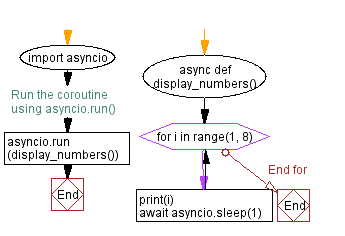Printing numbers with a delay using asyncio coroutines in Python
Python Asynchronous: Exercise-3 with Solution
Write a Python program that creates an asyncio event loop and runs a coroutine that prints numbers from 1 to 7 with a delay of 1 second each.
Sample Solution:
Code:
import asyncio
async def display_numbers():
for i in range(1, 8):
print(i)
await asyncio.sleep(1)
# Run the coroutine using asyncio.run()
asyncio.run(display_numbers())
Output:
1 2 3 4 5 6 7
Explanation:
In the above exercise-
The "display_numbers()" function is an asynchronous coroutine. It uses the 'await' keyword to introduce a pause using await asyncio.sleep(1) after printing each number. This 'sleep()' function introduces a 1 second delay.
The asyncio.run() function runs the “display_numbers()” coroutine. This function is introduced in Python 3.7 and provides a simple and clean way to run an asynchronous function in an event loop.
- Inside the event loop created by asyncio.run(), the display_numbers() coroutine is executed.
- For each iteration of the loop (from 1 to 7), the current number is displayed, and then the coroutine is paused for 1 second using await asyncio.sleep(1).
Flowchart:

Previous: Running asynchronous Python functions with different time delays.
Next: Fetching data asynchronously from multiple URLs using Python async IO.
What is the difficulty level of this exercise?
Test your Programming skills with w3resource's quiz.
- Weekly Trends and Language Statistics
- Weekly Trends and Language Statistics